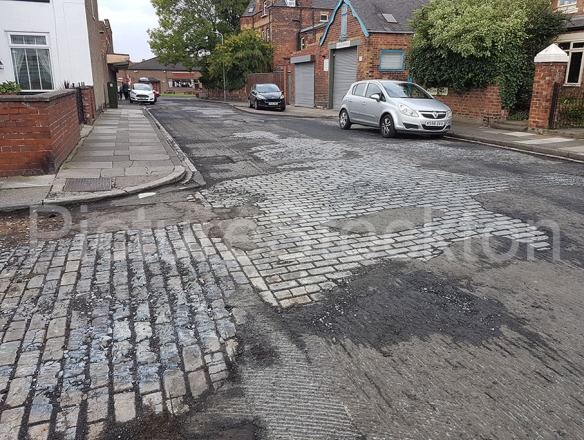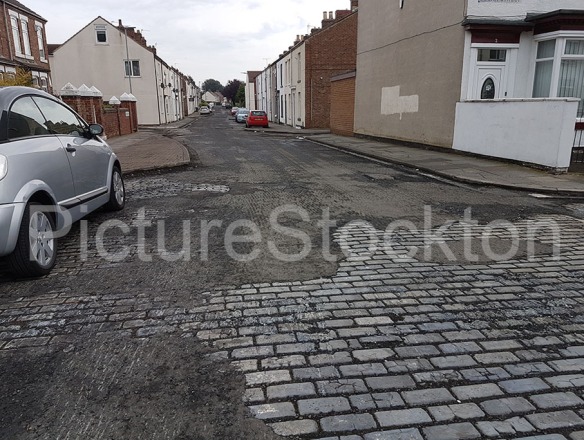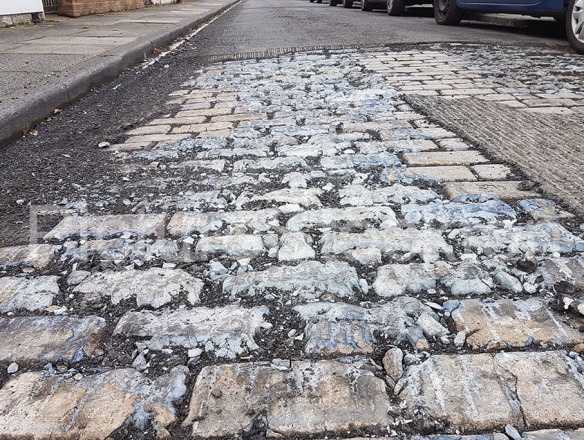Some recent road resurfacing work in the Hallifield and Edgar Street area of Norton has exposed the original cobble or more precisely brick road surface which was probably first tarmaced over in the 1960’s both as a cost saving measure and as an easy option to save the hard work of digging the road up.
These blue bricks are scoria bricks and were made from blast furnace slag which was a by-product, actually a waste product of the iron and steel foundrys which once employed many men in the Stockton area. The bricks were so successful that they were actually exported around the world and in 1912 alone over 62,000 tons of scoria bricks were shipped from the River Tees to countries including Canada and the West Indies to Belgium and Holland in Europe and even as far as South Africa were roads made from Teesside scoria brick can still be seen today and not just covered by tarmac. Truly another great Teesside export story!
The only road I know of within the Stockton Borough were the scoria bricks remain uncovered is Mill Street off Norton High Street? I always find the architecture of this street fascinating and the name alone gives a nod to what once stood at the top of it’s bank and perhaps the bricks have been left with it’s history in mind? Well, I like to think so anyway.
Photographs and details courtesy of David Thompson.





I visited Bute Street recently, and it is still holding on to its original character, apart from the odd satellite dish. The blue brick ‘cobbles’ can be seen here and in neighbouring streets.
LikeLike
Calf Fallow Lane was covered with this type of brick before its demolition. I also remember some hexagonal shapes being used as road surfaces.
LikeLike
All the back streets around Fulthorpe, Jameson and Fife Roads in Norton are paved with these blue bricks and I remember in the late 1960s the sand quarry (later the William Newton field) was the dumping ground for the road bricks which were dug up from Stockton High Street.
LikeLike
Frank, I can throw some light on the week-long high temperature annealing treatment that the bricks got, after being cast. It results in the growth of various types of crystals which probably improve hardness and toughness. Slag is a kind of glass and therefore brittle. Perhaps the treatment changed the colour as well..
As it happens, a couple of weeks back I was giving an after dinner speech to the Molten Salts Discussion Group at Nottingham University. Don’t laugh! The two inventors of a new electrolytic process for making cheap titanium, using molten salts, were the honoured guests. This very important, and novel, British invention is now being used commercially
I wasn’t sure what to talk about to the Discussion Group, when I realised that molten slag has some of the characteristics of a molten salt, So, inter alia, I mentioned my time working for the British Iron and Steel Research Association, in 1964, at a disused site in Redcar( where the closed down big blast furnace stands. The work there was to make wear resistant tiles out of blast furnace slag. This was done by mixing various oxides into the molten slag and after casting, heating the solid tiles at red heat for a couple of days. The oxides, I suppose speeded up the growth of the crystals and gave a more consistent product.
I understand that the project died as the finished tiles proved too hard to cut or polish!
LikeLiked by 1 person
Fred the things we Engineers learn as asides to our profession. ICI used Blue bricks in drainage channels because they were totally water proof or so the Bricklayers Foreman told me.
They were made in Middlesbrough by the Tees Scoriae brick Company from molten slag from the furnace bottom. Tipped into moulds then annealed for several days they came out blue and very hard, the company was still making bricks up to the late 1960’s I believe, again that was word of mouth so could be wrong. Because they could be moulded into various shapes they were easy to lay down and Stockton was one of the first to use them. Us older lads and lasses remember the High Street side streets back alley’s all being blocks even some back yards.
Most were removed though some simply tarred over, my memory of them was driving on them when wet was a bit like driving on ice, rod and cable brakes were bad enough but on those blocks you went the extra mile with locked wheels.
Scoriae means dung, where that comes into the equation I am not sure?
Frank.
LikeLike
Named Scoriae as it was a waste product from the steel making industry.
LikeLike
I thought that blast furnace slag tended to be light in colour? Older readers may remember the line of greyish white slag tips that used to line the south side of the River, more or less opposite the present Tees Barrage.
I would guess that the slag was remelted before being cast into bricks and perhaps mixed with steel plant slag which I think was darker…
LikeLike
You will also find these bricks, or setts, in High Church Wynd in Yarm…. I also think I have seen one with a makers name stamped on it.
LikeLike
They are in the back ally of Mowbray Road and have been covered. They are in every street around that area but have been covered by tarmac.
LikeLike
The approaches to the Transporter Bridge on both sides had Cobbles when I was a boy “1950s”, they are very hard wearing and probably would outlast any Tarmac product for generations.
LikeLike
Great post, very informative.
LikeLike
Is Bute Street still stuck in a similar time warp?
https://picturestocktonarchive.wordpress.com/2007/08/20/bute-street-stockton-c1990s/
https://goo.gl/maps/KSprCfiWi2k
LikeLike
Although I’ve walked and photographed along Dovecot Street and across to Yarm Lane I’ve never gone to the north towards the railway station except to photograph the old school in Palmerston Street which is now the Salvation Army Hostel and Bute Street appears to be a little gem of a find. Thanks Jonathan! There is a 2006 conservation report on the street here;
Click to access c02-bute-street.pdf
LikeLike
I was brought up in Bute Street from 1942 and glad to note that someone else realises that the Street is still in the time warp – as needed for a street preserved for its historic interest (thanks for the link). My late mother Chrissie Marshall was highly involved in pushing the case for keeping the street as is. I have lived in Australia since 1971 and get back from time to time – so glad the street is the still the same as it was during my childhood.
If you walk to the end of the street where the wall is you should see some damaged bricks on the ground – the results of a November 5 bonfire!!
LikeLike